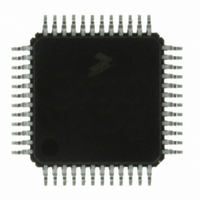MC9S08DZ60ACLF Freescale Semiconductor, MC9S08DZ60ACLF Datasheet - Page 147

MC9S08DZ60ACLF
Manufacturer Part Number
MC9S08DZ60ACLF
Description
IC MCU 60K FLASH 4K RAM 48-LQFP
Manufacturer
Freescale Semiconductor
Series
HCS08r
Datasheets
1.DEMO9S08DZ60.pdf
(416 pages)
2.EVB9S08DZ60.pdf
(4 pages)
3.MC9S08DZ48AMLF.pdf
(458 pages)
Specifications of MC9S08DZ60ACLF
Core Processor
HCS08
Core Size
8-Bit
Speed
40MHz
Connectivity
CAN, I²C, LIN, SCI, SPI
Peripherals
LVD, POR, PWM, WDT
Number Of I /o
39
Program Memory Size
60KB (60K x 8)
Program Memory Type
FLASH
Eeprom Size
2K x 8
Ram Size
4K x 8
Voltage - Supply (vcc/vdd)
2.7 V ~ 5.5 V
Data Converters
A/D 16x12b
Oscillator Type
External
Operating Temperature
-40°C ~ 85°C
Package / Case
48-LQFP
Processor Series
S08DZ
Core
HCS08
Data Bus Width
8 bit
Data Ram Size
4 KB
Interface Type
CAN, I2C, SCI, SPI
Maximum Clock Frequency
40 MHz
Number Of Programmable I/os
53
Number Of Timers
2
Operating Supply Voltage
5.5 V
Maximum Operating Temperature
+ 85 C
Mounting Style
SMD/SMT
3rd Party Development Tools
EWS08
Development Tools By Supplier
DEMO9S08DZ60
Minimum Operating Temperature
- 40 C
On-chip Adc
12 bit, 24 Channel
For Use With
DEMO9S08DZ60 - BOARD DEMOEVB9S08DZ60 - BOARD EVAL FOR 9S08DZ60
Lead Free Status / RoHS Status
Lead free / RoHS Compliant
Available stocks
Company
Part Number
Manufacturer
Quantity
Price
Company:
Part Number:
MC9S08DZ60ACLF
Manufacturer:
FREESCAL
Quantity:
1 250
Company:
Part Number:
MC9S08DZ60ACLF
Manufacturer:
Freescale Semiconductor
Quantity:
10 000
- Current page: 147 of 458
- Download datasheet (5Mb)
7.3
Addressing modes define the way the CPU accesses operands and data. In the HCS08, memory, status and
control registers, and input/output (I/O) ports share a single 64-Kbyte CPU address space. This
arrangement means that the same instructions that access variables in RAM can also be used to access I/O
and control registers or nonvolatile program space.
MCU derivatives with more than 64-Kbytes of memory also include a memory management unit (MMU)
to support extended memory space. A PPAGE register is used to manage 16-Kbyte pages of memory which
can be accessed by the CPU through a 16-Kbyte window from 0x8000 through 0xBFFF. The CPU includes
two special instructions (CALL and RTC). CALL operates like the JSR instruction except that CALL saves
the current PPAGE value on the stack and provides a new PPAGE value for the destination. RTC works
like the RTS instruction except RTC restores the old PPAGE value in addition to the PC during the return
from the called routine. The MMU also includes a linear address pointer register and data access registers
so that the extended memory space operates as if it was a single linear block of memory. For additional
information about the MMU, refer to the Memory chapter of this data sheet.
Some instructions use more than one addressing mode. For instance, move instructions use one addressing
mode to specify the source operand and a second addressing mode to specify the destination address.
Instructions such as BRCLR, BRSET, CBEQ, and DBNZ use one addressing mode to specify the location
of an operand for a test and then use relative addressing mode to specify the branch destination address
when the tested condition is true. For BRCLR, BRSET, CBEQ, and DBNZ, the addressing mode listed in
the instruction set tables is the addressing mode needed to access the operand to be tested, and relative
addressing mode is implied for the branch destination.
7.3.1
In this addressing mode, operands needed to complete the instruction (if any) are located within CPU
registers so the CPU does not need to access memory to get any operands.
7.3.2
Relative addressing mode is used to specify the destination location for branch instructions. A signed 8-bit
offset value is located in the memory location immediately following the opcode. During execution, if the
branch condition is true, the signed offset is sign-extended to a 16-bit value and is added to the current
contents of the program counter, which causes program execution to continue at the branch destination
address.
7.3.3
In immediate addressing mode, the operand needed to complete the instruction is included in the object
code immediately following the instruction opcode in memory. In the case of a 16-bit immediate operand,
Freescale Semiconductor
Addressing Modes
Inherent Addressing Mode (INH)
Relative Addressing Mode (REL)
Immediate Addressing Mode (IMM)
For more information about extended addressing modes, see the Memory
Management Unit section in the Memory chapter.
MC9S08DZ128 Series Data Sheet, Rev. 1
NOTE
Chapter 7 Central Processor Unit (S08CPUV5)
147
Related parts for MC9S08DZ60ACLF
Image
Part Number
Description
Manufacturer
Datasheet
Request
R
Part Number:
Description:
Manufacturer:
Freescale Semiconductor, Inc
Datasheet:
Part Number:
Description:
Manufacturer:
Freescale Semiconductor, Inc
Datasheet:
Part Number:
Description:
Manufacturer:
Freescale Semiconductor, Inc
Datasheet:
Part Number:
Description:
Manufacturer:
Freescale Semiconductor, Inc
Datasheet:
Part Number:
Description:
Manufacturer:
Freescale Semiconductor, Inc
Datasheet:
Part Number:
Description:
Manufacturer:
Freescale Semiconductor, Inc
Datasheet:
Part Number:
Description:
Manufacturer:
Freescale Semiconductor, Inc
Datasheet:
Part Number:
Description:
Manufacturer:
Freescale Semiconductor, Inc
Datasheet:
Part Number:
Description:
Manufacturer:
Freescale Semiconductor, Inc
Datasheet:
Part Number:
Description:
Manufacturer:
Freescale Semiconductor, Inc
Datasheet:
Part Number:
Description:
Manufacturer:
Freescale Semiconductor, Inc
Datasheet:
Part Number:
Description:
Manufacturer:
Freescale Semiconductor, Inc
Datasheet:
Part Number:
Description:
Manufacturer:
Freescale Semiconductor, Inc
Datasheet:
Part Number:
Description:
Manufacturer:
Freescale Semiconductor, Inc
Datasheet:
Part Number:
Description:
Manufacturer:
Freescale Semiconductor, Inc
Datasheet:











